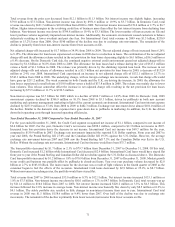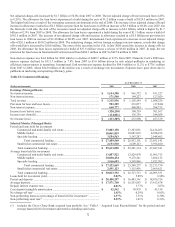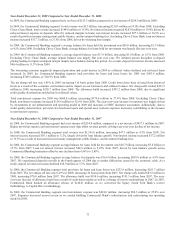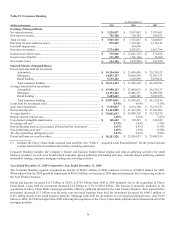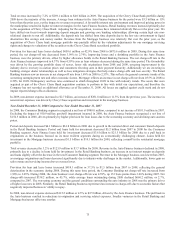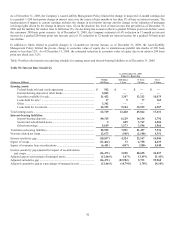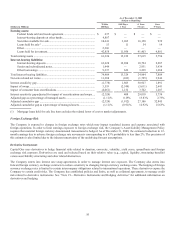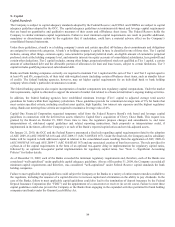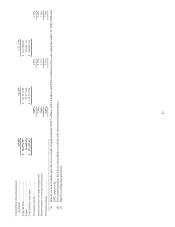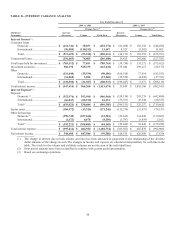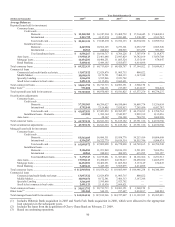Capital One 2009 Annual Report Download - page 94
Download and view the complete annual report
Please find page 94 of the 2009 Capital One annual report below. You can navigate through the pages in the report by either clicking on the pages listed below, or by using the keyword search tool below to find specific information within the annual report. 81
Covenants
In connection with the issuance of certain of its trust preferred capital securities, The Company has entered into a Replacement Capital
Covenant (“RCC”) granting certain rights to the holders of “covered debt,” as defined in the RCC, that prohibit the repayment,
redemption or purchase of the trust preferred capital securities except, with limited exceptions, to the extent that the Company has
received specified amounts of proceeds from the sale of certain qualifying securities. Currently, the Company’s covered debt is its
5.35% Subordinated Notes due May 1, 2014. For more information regarding this covenant, reference is made to the RCC entered into
by the Corporation in connection with the issuances of such trust preferred capital securities, which are filed with the SEC under
Forms 8-K. The Company will provide a copy of the RCC to holders of the covered debt upon request made to Investor Relations.
The terms of certain lease and credit facility agreements related to other borrowings and operating leases require several financial
covenants (including performance measures and equity ratios) to be met. If these covenants are not met, there may be an acceleration
of the payment due dates noted in Table 28: Contractual Funding Obligations. As of December 31, 2009, the Company was not in
default of any such covenants.
IX. Market Risk Management
Market risk is the risk that earnings or economic value of equity will be adversely impacted due to changes in interest rates, foreign
exchange rates, or other financial market asset prices. Banks are inevitably exposed to interest rate risk due to the repricing and
maturity mismatches of their assets and liabilities, as well as the need to invest most of their equity in financial assets. Banks must
often trade-off managing near-term earnings volatility with market value volatility and achieve this objective by targeting moderate
levels of each.
Capital One uses industry standard market risk measurement techniques and analysis to measure the impact of interest rate or foreign
exchange rate changes on earnings and the economic value of equity. Capital One’s measurement and management of market risk
considers both earnings and market value exposures. The Company’s interest rate risk management objective is to position the interest
rate risk profile (e.g., duration, convexity, volatility, yield curve, spread/basis) based on prevailing market conditions and long-term
expectations.
Interest Rate Risk
Like other banks, the Company borrows money from other institutions and depositors, which it uses to make loans to customers and to
invest in debt securities and other earning assets. The Company earns interest on these loans and assets and pays interest on the money
it borrows from institutions and depositors. If the rate of interest it pays on its borrowings and deposits increases more than the rate of
interest it earns on its assets, the Company’s net interest income, and therefore its earnings, will be diminished. The Company’s
earnings could also be negatively impacted if the interest rates it charges on its earning assets fall more quickly than the rates it pays
on its borrowings and deposits. Changes in interest rates and competitor responses to those changes may affect the rate of customer
payments or pre-payments for mortgages, auto, installment loans and commercial loans and may affect the balances customers carry
on their credit cards. These changes can reduce the overall yield on its earning asset portfolio. Changes in interest rates and competitor
responses to these changes may also impact customer decisions to maintain balances in the deposit accounts they have with the
Company. These changes may require the Company to replace withdrawn balances with higher cost alternative sources of funding.
In addition to the impact to earnings, interest rate risk also refers to changes in the net present value of assets and off-balance sheet
positions less liabilities (termed “economic value of equity”) due to interest rate changes. Economic value of equity could be affected
to the extent that the market value of the Company’s assets, liabilities and off-balance sheet positions do not respond equally to
changes in interest rates.
The Company manages its interest rate sensitivity through several techniques, which include, but are not limited to, changing the
maturity and re-pricing characteristics of various balance sheet categories and by entering into interest rate derivatives.
The measurement of interest rate risk is impacted by modeling and underlying forecast assumptions. In addition, the measurement of
interest rate sensitivity includes assumptions on the ability of management to take action to manage exposure to changes in interest
rates and foreign exchange, including, within legal and competitive constraints, the re-pricing of interest rates on outstanding credit
card loans and deposits. The consolidated balance sheet and all off-balance sheet positions are included in the analysis. The analysis
reflects known balances and contractual maturities when available. Balance sheet positions lacking contractual maturities and those
with a likelihood of maturity prior to their contractual term are assumed to mature consistent with business line expectations or, when
available in the case of deposits, loans and marketable securities, assumptions derived from empirical results and industry-standard
modeling approaches.


